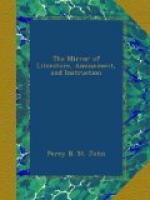* * * * *
THE PIED OYSTER CATCHER.
This separate and single genus of birds is seldom seen amongst the numerous descriptions of wild fowl, which, in the winter seasons, wing their flight to our marshes. The most striking part of the Oyster-catcher is its bill, the colour of which is scarlet, measuring in length nearly four inches, wide at the nostrils, and grooved beyond them nearly half its length: thence to the tip it is vertically compressed on the sides, and ends obtusely. With this instrument, which in its shape and structure is peculiar to this bird, it easily disengages the limpets from the rocks, and plucks out the oysters from their half-opened shells, on which it feeds, as well as on other shell-fish, sea-worms, and insects.
W.G.C.
* * * * *
BUTTERFLIES.
The splendid appearance of the plumage of tropical birds is not superior to what the curious observer may discover in a variety of Lepidoptera; and those many-coloured eyes, which deck so gorgeously the peacock’s tail, are imitated with success in Vanessa Io, one of our most common butterflies. “See,” exclaims the illustrious Linnaeus, “the large, elegant, painted wings of the butterfly, four in number, covered with small imbricated scales; with these it sustains itself in the air the whole day, rivalling the flight of birds, and the brilliancy of the peacock. Consider this insect through the wonderful progress




